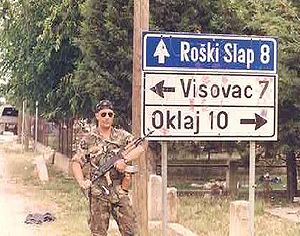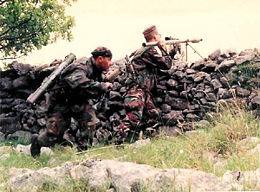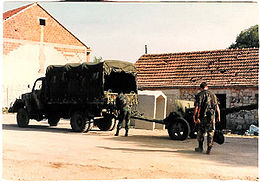
Miljevci plateau battle
Encyclopedia

Krajina
-Etymology:In old-Croatian, this earliest geographical term appeared at least from 10th century within the Glagolitic inscriptions in Chakavian dialect, e.g. in Baška tablet about 1105, and also in some subsequent Glagolitic texts as krayna in the original medieval meaning of inlands or mainlands...
Territorial Defense positions in the area of the Miljevci
Miljevci
Miljevci or Miljevci plateau is a small region in Šibenik-Knin County in Croatia that includes seven villages. The plateau has an area of over 100 square kilometers and is located between the rivers of Krka, Čikola and mountain Promina. Miljevci are only a few kilometers from the town of Drniš in...
Plateau, located in the Dalmatia
Dalmatia
Dalmatia is a historical region on the eastern coast of the Adriatic Sea. It stretches from the island of Rab in the northwest to the Bay of Kotor in the southeast. The hinterland, the Dalmatian Zagora, ranges from fifty kilometers in width in the north to just a few kilometers in the south....
n hinterland near Drniš
Drniš
Drniš is a town in Croatia, located in inland Dalmatia at halfway between Šibenik and Knin. Its municipality population is 8,595 , with 3,332 in the town itself and the rest in two dozen surrounding villages...
, and succeeded in regaining control over some 90 km2 of Croatian territory. This operation took place in UNPA
UNPA
The abbreviation UNPA can refer to several different entities:* In India, the United National Progressive Alliance* In the United Nations:**United Nations Parliamentary Assembly, a proposed elected parliament for the UN...
sector South and was witnessed by UNPROFOR peackeepers who did not become involved in the fighting.
This relatively minor battle, fought by formations no bigger than a company, was significant for two reasons; it was the first wholly successful offensive action by the still-fledgling Croatian army after the round of ceasefires and truces which brought a halt to the first phase of the Croatian War of Independence
Croatian War of Independence
The Croatian War of Independence was fought from 1991 to 1995 between forces loyal to the government of Croatia—which had declared independence from the Socialist Federal Republic of Yugoslavia —and the Serb-controlled Yugoslav People's Army and local Serb forces, with the JNA ending its combat...
in early January, 1992, and the actions of the Croatian victors in the immediate aftermath of the battle are the subject of an ongoing investigation into possible war crimes.
Background
The opening phase of the Croatian War of IndependenceCroatian War of Independence
The Croatian War of Independence was fought from 1991 to 1995 between forces loyal to the government of Croatia—which had declared independence from the Socialist Federal Republic of Yugoslavia —and the Serb-controlled Yugoslav People's Army and local Serb forces, with the JNA ending its combat...
, from July 1991 to the imposition of an uneasy UN-brokered ceasefire in early January 1992, resulted in an uneasy standstill between the fledgling Croatian state, that had gained support from the international community, but at the severe cost of losing almost a third of its territory to ethnic Serb
Serbs of Croatia
Višeslav of Serbia, a contemporary of Charlemagne , ruled the Županias of Neretva, Tara, Piva, Lim, his ancestral lands. According to the Royal Frankish Annals , Duke of Pannonia Ljudevit Posavski fled, during the Frankish invasion, from his seat in Sisak to the Serbs in western Bosnia, who...
rebels of the Republic of Serbian Krajina
Republic of Serbian Krajina
The Republic of Serbian Krajina was a self-proclaimed Serb entity within Croatia. Established in 1991, it was not recognized internationally. It formally existed from 1991 to 1995, having been initiated a year earlier via smaller separatist regions. The name Krajina means "frontier"...
headquartered in Knin
Knin
Knin is a historical town in the Šibenik-Knin county of Croatia, located near the source of the river Krka at , in the Dalmatian hinterland, on the railroad Zagreb–Split. Knin rose to prominence twice in history, as a one-time capital of both the Kingdom of Croatia and briefly of the...
, openly backed by the Serbian-controlled Yugoslav People's Army
Yugoslav People's Army
The Yugoslav People's Army , also referred to as the Yugoslav National Army , was the military of the Socialist Federal Republic of Yugoslavia.-Origins:The origins of the JNA can...
(JNA), that had pressed home their near-total superiority in artillery, armour and air power over the newly formed Croatian army.
The fighting in the mountainous Dalmatian hinterland was a furious duel of unrelenting front-wide Serb pressure and frenzied Croatian holding actions and local counterattacks. The front lines left after the Operation Coast-91 made the Croatian positions at the Adriatic coast, including the major cities of Zadar
Zadar
Zadar is a city in Croatia on the Adriatic Sea. It is the centre of Zadar county and the wider northern Dalmatian region. Population of the city is 75,082 citizens...
and Šibenik
Šibenik
Šibenik is a historic town in Croatia, with population of 51,553 . It is located in central Dalmatia where the river Krka flows into the Adriatic Sea...
exposed to attack from not only the Serb artillery and aircraft, but also mortar fire.
All of the Dalmatian coastal cities were left without an overland link to the rest of Croatia and could only be reached by air or by sea from Rijeka
Rijeka
Rijeka is the principal seaport and the third largest city in Croatia . It is located on Kvarner Bay, an inlet of the Adriatic Sea and has a population of 128,735 inhabitants...
, further north.
At Christmas 1991, a major combined-arms attack with artillery and armour involvement on the northern flank of the front beat the Serbs back from the outskirts of Zadar and seized the southern shore of the Maslenica Strait, the site of a key Maslenica Bridge
Maslenica Bridge (D8)
The Maslenica Bridge is a deck arch bridge carrying the D8 state road approximately to the west of the settlement of Maslenica, Croatia and south of the D54 and D8 state roads junction.- Structure :...
.
Croatian morale was high and preparations were underway to recapture more territory when a UN-brokered ceasefire came into effect in the first week of January, 1992, and, with it, international peacekeepers moved in to monitor the front line.
Tense ceasefire
The cease-fire which brought the bulk of the fighting to a halt gradually became resented by the Croatian units at the frontlines, who, in large part, were made up of local men who had either been forced from their homes by the fighting or had come from nearby towns and cities which the Serbs had shelled or attacked from the air. Casualties were widespread, some also in the atrocities committed by Serb forces such as the Škabrnja massacreŠkabrnja massacre
Škabrnja massacre was a war crime committed by Serb Army forces during the Croatian War of Independence. On November 18, 1991, Serb paramilitaries, supported by the JNA, captured the village of Škabrnja and killed 25 Prisoners of war and 61 civilians over the next several days.-Before the...
and Bruška massacre
Bruška massacre
The Bruška massacre took place on 21 December 1991 in Bruška, a small village near the Croatian town of Benkovac when Serbian paramilitaries executed 10 civilians in the hamlet of Marinovići...
, in locations not far from the Miljevci plateau.
As the cease-fire did not include any provision for the enforcement of compliance with its terms, violations carried no consequences - the UN forces stationed at the frontline could only report on violations, and could take action only if they came under direct attack. The Serb forces took full advantage of this, routinely pounding Zadar, Šibenik, Sinj and villages throughout the region with artillery and unguided rockets, and openly working with JNA units which, under the terms of the ceasefire, were required to withdraw to FR Yugoslavia.
Increasingly vehement Croatian protests to the UN authorities over the violations went without concrete action being taken, and resulted in the Croatian Supreme Command issuing orders to its frontline units that they may engage the enemy in response to a direct attack, in the event of a major violation of ceasefire terms, or if war crimes in progress were observed.
The battle
Croatian patience snapped on the MiljevciMiljevci
Miljevci or Miljevci plateau is a small region in Šibenik-Knin County in Croatia that includes seven villages. The plateau has an area of over 100 square kilometers and is located between the rivers of Krka, Čikola and mountain Promina. Miljevci are only a few kilometers from the town of Drniš in...
Plateau, north of Šibenik and west of Drniš
Drniš
Drniš is a town in Croatia, located in inland Dalmatia at halfway between Šibenik and Knin. Its municipality population is 8,595 , with 3,332 in the town itself and the rest in two dozen surrounding villages...
in late June 1992. The villages of Miljevci were ethnically Croatian but had been occupied by Serbs in 1991. Local Croatian commanders launched an apparently impromptu attack in response to JNA troops being observed at the Serb positions opposing them; a violation of the ceasefire, and grounds to engage the enemy under the Croatian forces' standing orders.
The Croatian forces were composed of the 113th (Šibenska - of Šibenik) Infantry Brigade and 142nd (Drniška - of Drniš
Drniš
Drniš is a town in Croatia, located in inland Dalmatia at halfway between Šibenik and Knin. Its municipality population is 8,595 , with 3,332 in the town itself and the rest in two dozen surrounding villages...
) Infantry Brigade of the Croatian Ground Army
Croatian ground army
The Croatian Army is a branch of the Armed Forces of the Republic of Croatia.The fundamental role and purpose of the Croatian Army is to protect vital national interests of the Republic of Croatia and defend the sovereignty and territorial integrity of the state.Basic tasks of the Croatian Army...
. On the night of June 20, advancing north, they crossed the Čikola
Čikola
Čikola is a river of 47.8 km in length, located in Dalmatia, southern Croatia.Čikola river's springs is near the village Čavoglave, flows through the city of Drniš and then flows near village of Miljevci into the river of Krka which flows into Adriatic Sea.-See also:*Krka*Krka National Park...
River and climbed the Miljevci Plateau. Most of the 142nd brigade remained in reserve, while the 113th moved on.
Elements of the elite 4th Guards Brigade (Motorized) and the Ministry of Defence
Ministry of Defence (Croatia)
The Ministry of Defence of the Republic of Croatia is the ministry in the Government of Croatia which is in charge of the nation's military. The ministry was established in 1990.-Ministers:-References:...
Special Operations Unit Bojna Zrinski
Zrinski
The Zrinski family was a Croatian noble family, influential during the period in history marked by the Ottoman wars in Europe in the Kingdom of Croatia and Hungary and in the later Austro-Hungarian Empire...
were rumored to have also been involved.

The attack went completely to plan. Caught by surprise, the much-superior Serb force of some 300 troops crumbled and fled. Širitovci was successfully seized early on, and Lt Budanko's men were able to cut off the Serb retreat and inflict heavy losses, including a T-55 tank destroyed in combat. By the following day, the Croats were in complete control of the area, the Serbs having withdrawn overland to the north.
On June 23, the Serb forces launched a counter-attack from Drniš. This was repelled with more losses of men and armour. In retaliation, Šibenik
Šibenik
Šibenik is a historic town in Croatia, with population of 51,553 . It is located in central Dalmatia where the river Krka flows into the Adriatic Sea...
was subjected to heavy Serb shelling.
Casualties and claims of war crimes

Serbia
Serbia , officially the Republic of Serbia , is a landlocked country located at the crossroads of Central and Southeast Europe, covering the southern part of the Carpathian basin and the central part of the Balkans...
proper, whose presence would have constituted a violation of the local ceasefire agreement.
Over the course of June 26 and 27, almost a week after the battle, Serb Krajina authorities sent civilians from Knin
Knin
Knin is a historical town in the Šibenik-Knin county of Croatia, located near the source of the river Krka at , in the Dalmatian hinterland, on the railroad Zagreb–Split. Knin rose to prominence twice in history, as a one-time capital of both the Kingdom of Croatia and briefly of the...
, with escort from French UNPROFOR troops, to retrieve the remains of Serb dead. They brought back at least 20 bodies with them.
Serb sources claim 40 Serb combat fatalities, several wounded and at least 17 taken prisoner. Even this lower figure would amount to some 15% of the total Serb personnel involved in the battle having been killed in action - a devastating outcome for any armed force.
The Serb village of Nos Kalik was completely destroyed, with one civilian killed, during earlier fighting in May, when Croatian forces stormed the village before withdrawing. A further eight local civilians were imprisoned on Prvić
Prvic
Prvić is a small island in the Croatian part of Adriatic Sea. It is situated in the Šibenik archipelago, about half a mile from the mainland, in the vicinity of Vodice...
and later on Obonjan, islands near Šibenik, before being released.

Aftermath
Two months after the fighting, in August 1992 the UNPROFOR oversaw an exhumation of the bodies of numerous Serbian casualties.The remains were located in a pit, some 10 meters deep, outside of the village of Drinovci, buried together with a pile of garbage. It took a team of speleologists and an army crane to excavate them. They were all decomposed to the point where persons could not be identified. The coroner on site described twenty body bags, mostly containing human remains, army uniforms and numerous missing body parts.
These remains were then transferred to the Serb authorities and re-examined together with all other Serbian fatalities from the battle.
The medical examiner in Knin reported that between July 7th and August 19th they had received a total of eighteen bodies on four occasions, also through UNPROFOR. After that they received three more bodies on September 1st.
A total of 40 individual bodies of Serb militiamen were assembled from the remains, which then underwent an identification process. Fourteen were recognized by relatives, two based on medical conditions, and three based on fingerprints. 28 bodies were buried in individual graves, and 12 were put to rest in a common grave at the Knin cemetery. According to Croatian sources, the bodies were those of soldiers who were killed in combat. Apparently, a Croatian commander issued orders for them to be buried at the local Orthodox cemetery with each grave marked, but this was not done by his subordinates.
UN General Secretary, Boutros Boutros Ghali informed the members of the UN Security Council about this event:
"On June 21, the Croatian army attacked positions of the Serbian Territorial Defense on the Miljevci Plateau near Drniš in the pink zone, south of the sector South and advanced several kilometers. The advance of the Croatian army was planned under the command of two brigades, and was the second in the same month. Both represent the breaking of the SarajevoSarajevoSarajevo |Bosnia]], surrounded by the Dinaric Alps and situated along the Miljacka River in the heart of Southeastern Europe and the Balkans....
agreement of June 2, 1992. In response to this, both UNPROFOR and the EC Observation Mission filed a protest asking the Croatian army to withdraw to the previous lines."
The UN Security Council issued Resolution 762
United Nations Security Council Resolution 762
United Nations Security Council Resolution 762, adopted unanimously on June 30, 1992, after reaffirming resolutions 713 , 721 , 724 , 727 , 740 743 , 749 , 752 , 757 , 758 , 760 and 761 , the Council urged all parties to honour their commitments to the United Nations plan in former Yugoslavia and...
, but the Croatian army did not withdraw.
External links
- article in the Slobodna DalmacijaSlobodna Dalmacija
Slobodna Dalmacija is a Croatian daily newspaper published in Split.The first issue of Slobodna Dalmacija was published on June 17, 1943 by Tito's Partisans in a cave on Mosor, a mountain near Split, which was occupied by the Italian army during that time. The paper was later published in various...
daily about the military operation itself, dated June 22, 1999.

